
One of the best things about yoga is that it's for everyone — at every age, body size and fitness level. And it can be a essential part of healthy aging.
"As our bodies age, it's really 'move it or lose it,'" says Joe Miller, RYT, CSCS, yoga instructor at YogaRenew Online Teacher Training. "Fortunately, regular exercise, including yoga practice, can help keep bodies healthy and strong well into the golden years."
Video of the Day
Video of the Day
A July 2021 review commentary in Advances in Geriatric Medicine and Research states that the benefits of yoga for seniors include increased mobility, reduced risk of slips and falls, protection against cognitive decline, increased flexibility, strength, and balance and improved sleep and mental well-being.
Yoga also addresses two of the most common complaints people have as they get older: stiff joints and muscle weakness.
"The more sedentary we are, the more likely we are to lose range of motion in our joints," Miller says. "And sarcopenia — the loss of strength and muscle mass — is a serious problem for many seniors, increasing the risk of falls and frailty."
To combat that, try this yoga flow, designed by Miller, if you're over 50 — though people of any age can benefit from the improved balance and increased core strength these poses provide.
Yoga Flow for People Over 50
1. Chair Pose (Utkatasana)
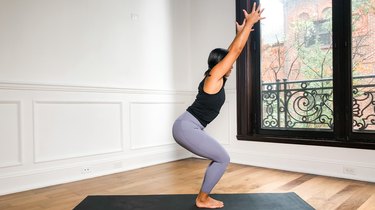
- Begin standing.
- Bend your ankles, knees and hips, as if you were going to sit on an imaginary chair behind you.
- Keep your chest lifting and each your arms overhead.
- Hold for several breaths before returning to standing.
"Chair pose works the quadriceps muscles of the thighs, as well as many back and shoulder muscles," Miller says. "It can help maintain strength in the muscles we use to sit down and get up from a chair."
2. Warrior I (Virabhadrasana I)
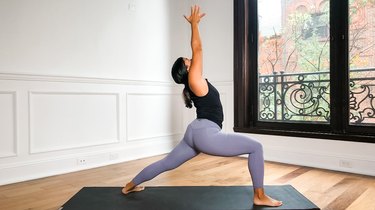
- Start standing, facing the front of your mat.
- Turn your left foot out about 45 degrees.
- Step your left foot back into a long lunge, lowering your heel to the floor while maintaining roughly the same angle of the foot. If your heel doesn’t reach the floor, shorten your stride or take your feet wider apart.
- Keep your shoulders and gaze facing more or less forward and raise your arms overhead.
- Hold for several breaths before stepping your left foot forward and repeating with your right leg back.
"Warrior I helps build stamina in the leg, back and shoulder muscles as well as mobility in the hips and ankles," Miller says.
3. Warrior II (Virabhadrasana II)
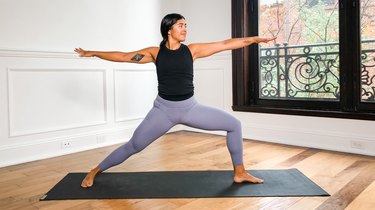
- Start with your feet wide apart, facing the side of your mat.
- Turn your left foot in slightly and your right thigh and foot out about 90 degrees.
- Bend your right knee and raise your arms to the side to about shoulder height.
- Keeping your chest facing more or less toward the side of the mat, turn your head to look in the direction of your right hand, if comfortable.
- Remain for several breaths, then switch legs.
"Warrior II helps maintain strength in the legs and mobility of the hips," Miller says.
4. Tree Pose (Vrksasana)
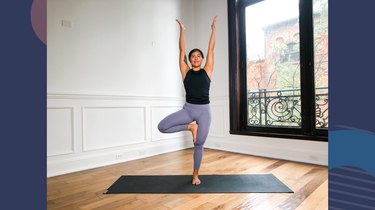
- Start standing. If you feel unstable at any point, place one hand on a nearly wall or piece of furniture to help your balance.
- Turn your right leg out so your toes point out.
- Bend your right knee and place your heel against the inside of your left ankle with your toes on the floor.
- If you feel stable there, try sliding the sole of your foot up to your inner shin.
- To make the pose more challenging, place the sole of your foot on your inner thigh or try raising your arms overhead.
- Repeat with your left leg.
"Because falls are so serious for the elderly, the U.S. Guidelines for Physical Activity specifically recommend seniors practice balance exercises," Miller says. "Tree pose is a [good] way to practice balancing on one foot."
5. Downward-Facing Dog (Adho Mukha Vrksasana)
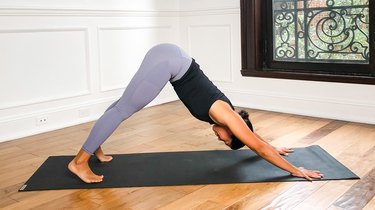
- Start on your hands and knees with your wrists under your shoulders.
- Extend your legs back to a plank with feet about hip-width apart.
- Lift your hips, forming an upside down V-shape with your body.
- Hold for several breaths.
"Downward-facing dog helps maintain ankle, hip and shoulder mobility as well as shoulder and arm strength," Miller says.
6. Plank Pose
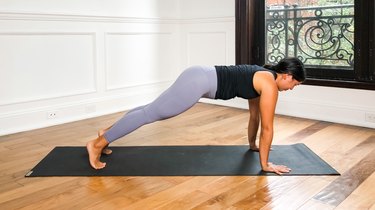
- Start on your hands and knees, with wrists under your shoulders.
- Extend your legs long with your toes tucked under, as in the top of a push-up.
- Maintain one line from your ankles to your knees, hips and shoulders, without letting your hips lift or sink.
- Over time, gradually build up to longer holds.
"Plank pose can help build strength and stamina in the wrist, arm and shoulder muscles, as well as the abdominal muscles," Miller says.
7. Locust Pose (Salabhasana)
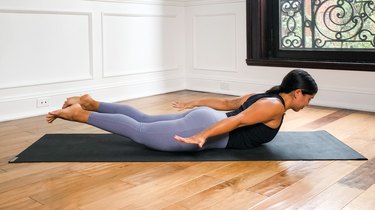
- Begin by lying on your belly with your hands alongside your hips.
- Raise your head, shoulders, chest, arms and legs from the floor and hold for several breaths.
"Locust pose is helpful for maintaining strength in the back as well as the extensor muscles of the hips, such as the glutes and hamstrings," Miller says. "These are the muscles that help to keep us upright against gravity."
8. Bridge Pose (Setu Bandha Sarvangasana)
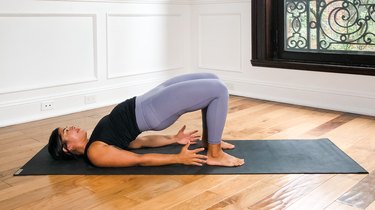
- Start by lying on your back with knees bent and the soles of your feet on the floor. Position your feet about hip-width apart.
- Lift your hips away from the floor. You can also press your arms into the floor to help lift your chest.
- Remain in the pose for several breaths.
"Bridge pose is also useful for keeping the extensor muscles of the hips and thighs strong," Miller says.
Was this article helpful?
150 Characters Max
0/150
Thank you for sharing!
Thank you for your feedback!